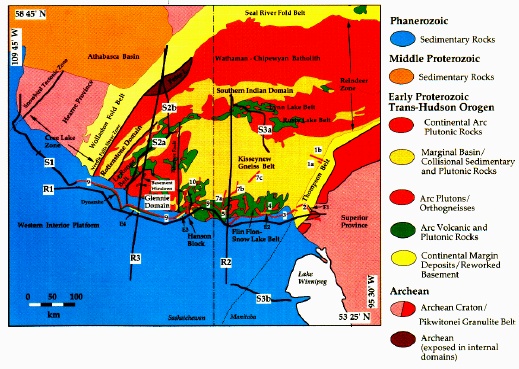The Trans-Hudson Orogen is the only fully preserved Early Proterozoic
orogenic belt in North America. It is the principal element
of a network of such belts that formed by Proterozoic crustal
accretion and the collision of pre-existing Archean continents.
In the case of the THO, the Archean continents are the Superior
Province to the southeast and the Hearne-Rae provinces to
the northwest. In northern Saskatchewan and Manitoba, the
500 km wide orogen includes four major lithotectonic zones:
- a southeast foreland zone;
- an internal zone of juvenile Proterozoic crust;
- an Andean-type magmatic arc batholith;
- a northwest hinterland zone (divided into smaller domains).
Figure 1. Geological map of the exposed Trans-Hudson Orogen
and boundary locations. LITHOPROBE seismic reflection lines
along which data were collected are shown in red, purple
and dark blue.

Seismic survey results indicate prominent, pervasive east-dipping
reflectors (not west-dipping as expected) throughout the
crust in the foreland zone where the orogen bounds the Superior
Province. Such results require major revision of current
geotectonic models of the boundary zone and perhaps of the
orogen as a whole. In the western segment of the orogen (in
the internal zone), a crustal scale culmination coincides
with the surface-defined arc-granitoid Glennie domain penetrated
by Archean basement "windows". This culmination
is interpreted as a previously unknown Archean microcontinent.
Figure 2. Migrated line drawing of seismic reflection data
collected along line 9 (see Fig. 1). Base of reflections (yellow
dots) represents the crust-mantle transition (reflection Moho).
The thickest crust (45 km; marked Root) is interpreted as a
trapped Archean microcontinent.

Figure 3. Geologic cross-section showing the principal
tectonostratigraphic units of the THO as constrained by reflection
profiles, potential
field maps, and surface and drillcord geology.

Ongoing work is focussed on:
- a corridor across the foreland boundary zone to characterize
its lateral variability in a region of significant interest
to the mining industry;
- corridors along and across the Glennie domain and the
magmatic arc to better define the newly discovered microcontinent;
- studying controversial aspects of individual domains and
their boundaries;
- corridors across the hinterland zone
into the Hearne-Rae provinces to investigate the northwest
boundary region
and the Snowbird
Tectonic Zone.
Publications
Transect Reports |
